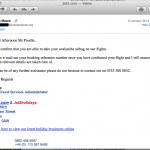In the last year, the regulations surrounding the carriage of avalanche airbags on airlines have been relaxed a little, but there’s still some confusion of what you can and can’t carry and where you can and can’t carry it.
The International Air Transport Association (IATA) is the trade association for the world’s airlines, representing some 240airlines, around 84% of total air traffic and help formulate industry policy on critical aviation issues. It is the IATA regulations which determine what you can and can’t carry, however there are often caveats in their regulations allow for things to be carried out at the discretion of the airline themselves or even, in some very specific cases, down to the pilot and crew on an individual flight.
If you’re flying with an empty cylinder, and intend getting it filled in resort, then you have no issues at all, however, depending on where you’re going, and which airbag you have that may not be feasible. So if you fly with a full cartridge, what then?
As airbags currently use compressed gas cylinders (there may be an electric airbag on the horizon, but we’ll leave that for another day), they fall within the regulations governing “Provisions for Dangerous Goods Carried by Passengers or Crew”. The relevant section for us is in Subsection 2.3 of that, in Table 2.3.A. which states you may have, on the aircraft:
Avalanche rescue backpack, one (1) per person, containing a cylinder of compressed gas in
Div. 2.2. May also be equipped with a pyrotechnic trigger mechanism containing less than
200 mg net of Div. 1.4S. The backpack must be packed in such a manner that it cannot be
accidentally activated. The airbags within the backpacks must be fitted with pressure relief
valves.
Note that there is no mention of volume of cylinder, only of the pyrotechnic charge (if there is one). The earlier regulations had s maximum capacity of 250ml which meant some airbags, such that those from BCA, could not be carried. The removal of that limit now means all airbags currently on the market comply wit IATA regulations.
However, while IATA state that they are permitted, there are the following stipulations:
- They may be carried in the hold, as checking in luggage.
- They may be carried as hand luggage.
- They may NOT be worn on your person (not really a problem as it’s not going to be a very comfortable flight if you’re sat wearing your rucksack for several hours)
- Pilot does not need to be informed of the location
- The approval of the operator is required.
It’s this last one that throws the cliched fly in the ointment. Ultimately, although IATA have cleared the airbags for carriage, it’s up to the airlines themselves to decide if they will allow it. Bear in mind too, however, that while IATA or the airlines may have no problem with you taking the airbags onboard as hand luggage, the CAA’s restriction on fluids and gases still apply at airport security, so you should make sure the cylinder, if full at least, it in your hold baggage otherwise you risk it being confiscated.
To further muddy the waters, in North America, the TSA (Transportation Security Administration) doesn’t allow filled compressed gas cylinders on board at all, for security reasons.
Now, as this is the internet this information is worth precisely what you’ve paid for it, but our understanding is that the TSA will only be checking bags when you are checking in for fly within the US on domestic flights, or your flight home. It’s been suggested by some that if you’re flying into the US and not taking a domestic flight thereafter, you could well get away with checking in a full cylinder. You’d just have to make sure it’s discharged (hopefully through choice) before you fly home.
We’ve taken a look at some of the more common airlines and tried to find out their policy on airbag systems, but we’re ignoring US domestic airlines for the obvious issues mentioned above.
- British Airways : Requires Approval, Contact BA in speaking to them, they require,in addition to the make and model of he pack, the dimensions of the cylinder, both external as well as volumetric so it can receive their security clearance.
- Swiss : Avalanche rescue backpack, max. 1 per passenger (not permitted to/from USA), must be registered with SWISS in advance
- Lufthansa : Accept avalanche airbags, but the document is quoting the old IATA regs with the 250ml restriction. We suggest you call to confirm.
- Monarch : Will accept airbags as long as they conform to IATA regs but must also be under 250ml in size. The 250ml is a Monarch policy.
- Air Canada : Avalanche rescue backpacks (one per passenger) are accepted as checked baggage as long as they meet IATA regs. No volume restriction, however the cylinder must remain installed in the backpack at all times. Replacement/spare cylinders are accepted in checked baggage only, and provided they are empty.
- American Airlines : No specific information and while is states compressed gas is forbidden, it refers you to other OneWorld partners, which includes BA, http://www.americanairlines.co.uk/i18n/travelInformation/baggage/restrictedArticles.jsp
- Jet2 : Very little info on the site itself other than to state: “To ensure your safety you must not include in your luggage, articles which are likely to endanger the aircraft, passengers or crew.”, and a link which takes you to the CAA site. However, in talking to them over the phone, they confirmed that airbags are permitted if they meet IATA regs, and I received this emailed response.
- Easyjet: I had a bit of trouble getting a straight answer out of Easyjet about their airbag policy.
If there’s an airline you’re unsure about or think we should include, please let us now in the comments. We will continue to update this post as and when we find more information out from various airlines.
Relevant Links:
IATA Consumer information site: http://www.iatatravelcentre.com/



Hi, helpful article. Do you have any information about KLM and Turkish airlines policy on airbags. Thanks
We haven’t looked into those airlines, but we will now
Thanks